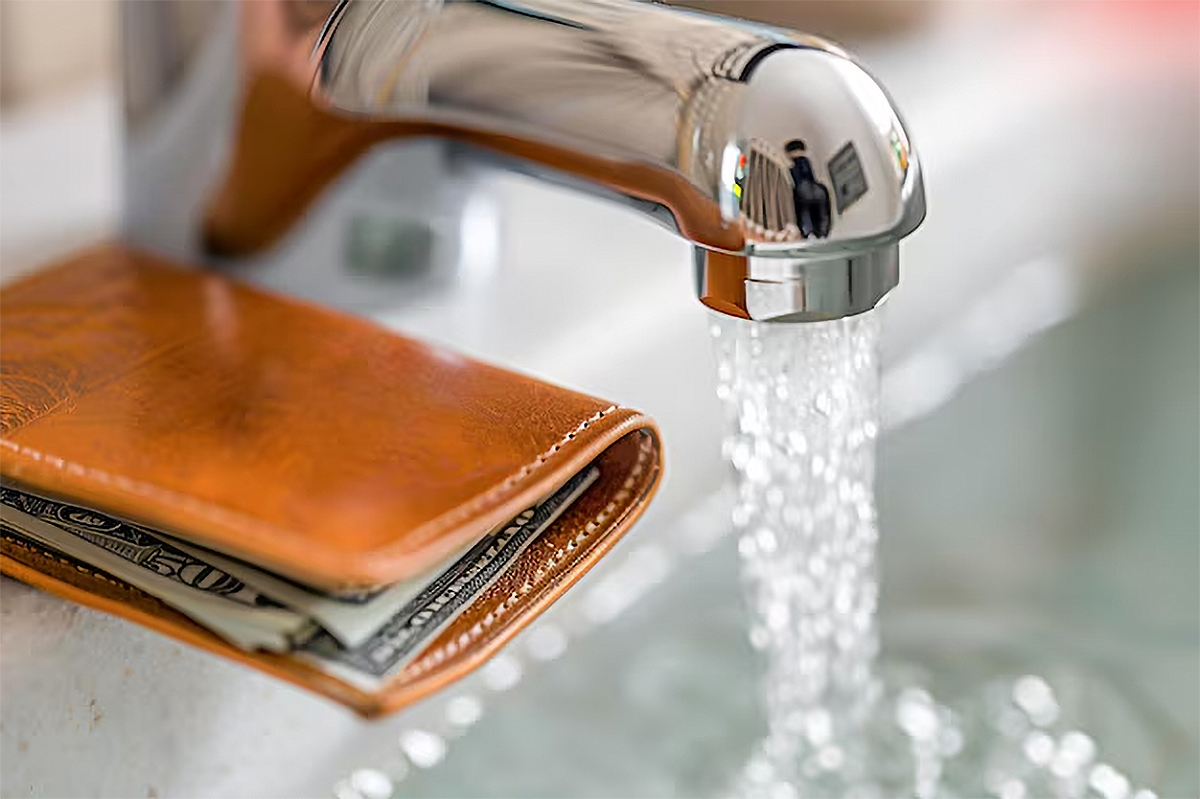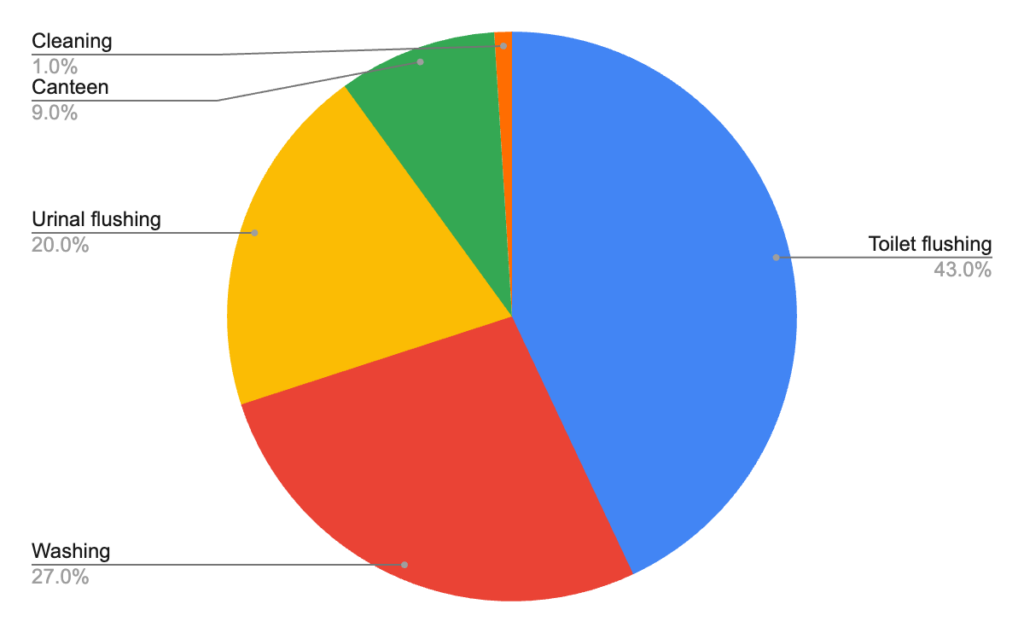How can I reduce the amount my business pays for water?

The amount of money your business spends on water is set to increase dramatically across the next five years, with virtually all water companies in England and Wales increasing prices to pay for infrastructure upgrades.
The extra amount you will pay depends on which water supplier you use and how much water you use. But it could run into thousands of pounds as this table illustrates:
How price rises will affect business water bills (2024 – 2029)
| Employees | Annual water use (cubic metres)* | Annual cost 2024-25** | Annual cost 2029-30*** | Increase in annual costs 2029-30 vs 2024-25 |
|---|---|---|---|---|
| 20 | 365 | £1,467 | £1,776 | £308 |
| 50 | 912.5 | £3,668 | £4,439 | £770 |
| 100 | 1825 | £7,337 | £8,878 | £1541 |
| 500 | 9125 | £36,685 | £44,388 | £7704 |
| 1000 | 18250 | £73,369 | £88,777 | £15,408 |
| 5000 | 91250 | £366,846 | £443,884 | £77,038 |
* On average, for office buildings, water consumption is 50L for each employee per day.
** Using average 2024-25 business rate of £4.02 for water and wastewater in England
*** Using average increase (21%) in cost of water and wastewater in England and Wales as announced by Ofwat 11 July 2024
It’s important to remember that if you manage multiple properties, or if you use water for irrigation or manufacturing processes, you will be looking at a much, much more drastic increase in water costs.
However, because virtually all businesses are charged based on the amount of water they receive through a meter you can at least take steps to offset the impact of the price rises.
5 ways to reduce your water bill
Put simply, if you use less water, you will pay less.
Here are our top 5 tips to reduce your business’s water consumption to reduce your water bill.
1. Use leak detection technology
A leaky tap or a leaky toilet is ‘money down the drain’, quite literally. Even a slowly dripping tap can waste thousands of litres of water a year. A leaky toilet can waste as much as 2,000 litres… a day!
Smart leak detectors like Sonic from Watergate can alert you to abnormal water use (e.g. leaks) and can prevent or minimise the damage when this happens by turning the water off. Check how to find a water leak.
They also give you valuable information about your everyday water usage so you can take action where needed. According to the Energy Saving Trust, people who have a way to keep tabs on their water usage tend to save 3 – 10% on their water bills straight away – and that’s before you consider what fixing hidden water leaks might save you.
If you have multi-occupancy properties the savings can add up to tens of thousands of pounds. In some of the properties where Watergate is deployed, we’ve found that up to 10% of rooms or apartments have pre-existing leaks.
As an added bonus, installing a leak detector may also secure you a discount on your buildings insurance premiums given the reduced leak damage risk.
2. Check if you can switch water supplier
Switching your water supplier might mean you get a better price.
Whilst consumers can’t switch water suppliers, most businesses, charities and public sector organisations in England, Wales and Scotland can.
There are a few conditions, so it’s worth using this eligibility checker if your business is based in England. For those in Scotland, you can choose from the Water Commission’s list of suppliers.
In Wales non-household customers who use more than 50 megalitres of water per year can also switch supplier and choose from the approved supplier list.
In Northern Ireland you can’t choose your own supplier – water is supplied by Northern Ireland Water.
Over 83% of companies in England have never changed their water supplier and are paying unnecessarily high water bills according to AquaSwitch. So if you’re eligible, it’s probably worth having a shop around to find the right deal for you or renegotiate with your existing supplier.
3. Install water-efficient fittings
Older water fittings were often made when water efficiency was less well understood. So consider replacing old equipment in your property with water-saving models which have the ECO label.
If you have an older toilet, it probably uses around 14 litres of water per flush, but newer dual flush systems use as little as 2.6 litres per flush. Other appliances such as low-flow taps and aerators or low volume shower heads also use less water without sacrificing performance.
Water efficient urinals will help you save water and the most efficient of these are waterless urinals. These might need a specialised cleaning regime but they often need less maintenance overall.
4. Use appliances wisely and when you’re away, turn off your water
Thinking about how you use the appliances in your business premises can make a massive difference to your water consumption. Wait until dishwashers and laundry machines are full before running them – running appliances on half loads wastes water.
If your company’s property is being left vacant for long periods of time, such as over the Christmas holidays, it’s worth shutting off the water supply when it’s safe to do so. This will prevent unnecessary water usage and from leaks from occurring while the building is empty. A simple way to minimise risk is to turn off the stopcocks when the building is left empty for several weeks (just remember to turn them back on again when you return!) If you’re leaving the building over times of the year when it’s likely to freeze then consider running taps dry too to minimize the risk of pipes freezing.
5. Encourage a water saving culture at work
Getting your wider team to support your water saving efforts is critical. In an average office-based building, water will likely be used in the following ways:

That means you need your team to do their bit. For example, if you run a canteen or restaurant in your office, make sure the staff are aware of your intention to save water.
If you’re lucky enough to have green spaces around your business premises then ask your gardeners to adopt water-smart landscaping practices – for example using native plants that are well-adapted to the local climate and require less water. Or considering smart irrigation systems which use sensors and weather data to adjust watering schedules based on real-time
